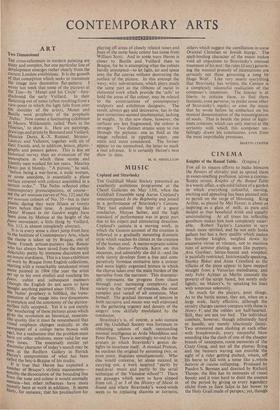CONTEMPORARY ARTS
.ART
Two Dimensional
Tim cross-references in modern painting are Many and complex, but one particular line of deitlopment emerges rather clearly from the current London exhibitions. It is the growth of that conception which seeks to transmute the image into decorative flat-pattern. I Wrote last week that some of the pictures at the Tate—by Manet and his Circle'—fore- shadowed the early Vuillard. In their flattening out of tones (often resulting from a view-point in which the light falls from over
the shoulder of the artist), Monet and Bazille were prophetic of the prophetic
Nabis.' Now comes a fascinating exhibition
lit Messrs. Wildenstein, called 'Paris in the Nineties,' to show it. Here are paintings,
drawings and prints by Bonnard and Vuillard, Maurice Denis, K.-X. Roussel, Serusier, Lautrec and Vallaton, together with six of
their friends, and, in addition, letters, photo- graphs and posters galore. This is less an
historical survey than an evocation of the atmosphere in which these serene and friendly men worked for ten years. Maurice
Denis put it bluntly. "A picture," he said,
" before beihg a war-horse, a nude woman, or some anecdote, is essentially a plane surface covered with colours assembled in a
certain order." The Nabis reflected other contemporary preoccupations, of course— See the art nouveau curves of No. 122 and the art nouveau colours of No. 35—but in their Plastic daring they were fifteen or twenty years before their time. A painting like DeMs' Women in the Garden might have been done by Matisse at the height of the Aloe movement; a little thing by Vuillard, No. 113, is almost completely abstract.
It is in every sense a short jump from here to the Institute of Contemporary Arts, where the theme is taken up by Braque, one of those French artisan-painters like Renoir who has always been saved from the merely delectably pretty by immense discretion and an innate sturdiness. This is a loan exhibition of work by Braque from English collections,
starting with a remarkably untalented street Scene painted in 1904 (the year the artist set up in his own studio) and touching his love, cubist and subsequent manners (though the English do not seem to have the anything painted since 1938). Here Lae Nabis' prophecy is fulfilled, the trans- Mutation of the image into two'dimensions is complete and the autonomy of the picture- Surface fully accepted. Yet it is not merely the weathering' of these pictures alone which Fives the revolution an historical, museum- like quality (for it must be remembered that Visual emphasis changes radically as the newspaper of a collage turns brown with age), but a realisation that the problem must have yet other solutions, more valid for our ,,,°Y‘711 times. The essentially similar yet dissimilar character of today's search may be se,,.ea at the Redfern Gallery in Patrick neon's compositions of what has been called the brit-A-Braque of his studio. It is true that Heron has exploited a number of Braque's stylistic mannerisms- notably the dissociation of the bounding line from the tone and colour it would normally contain—but other influences have more recently been at work M addition. It seems `'etY, for instance, that his predilection for
playing off areas of closely related tones and hues of the same basic colour has come from William Scott. And in some ways Heron is closer to Bazille and Vuillard than to Braque, for he is attempting what the cubists hardly attempted—to let light, air and space into the flat canvas without destroying the surface of the picture. In this attempt the wavy, wiry sub-structure, which plays much the same part as the ribbons of metal in cloisonné work which provide the 'cells' to hold the areas of flat colour, may •be related to the constructions of contemporary sculptors and exhibition designers. The result, always gay and decorative, has in the past sometimes seemed insubstantial, lacking in weight. In this new show, however, the surfaces are less fragmented, the colour is stronger. Two distinct strains seem to run through the pictures: one as fluid as the image reflected in rippling water, one static and more considered. The former • appear to me ,unresolved, the latter to mark a real advance. It is certainly Heron's best show to date.
M. 11, MIDDLL'i ON


































 Previous page
Previous page